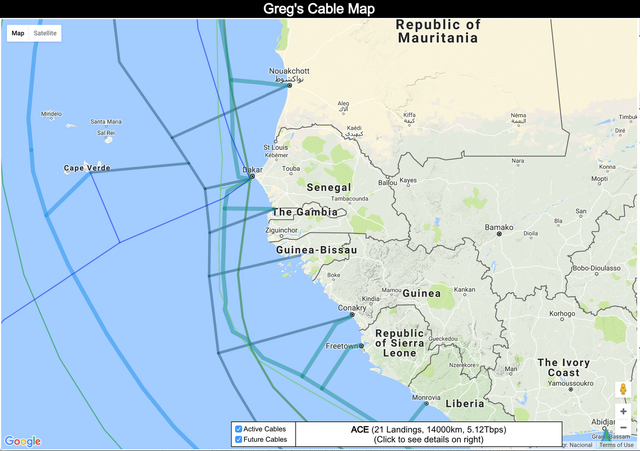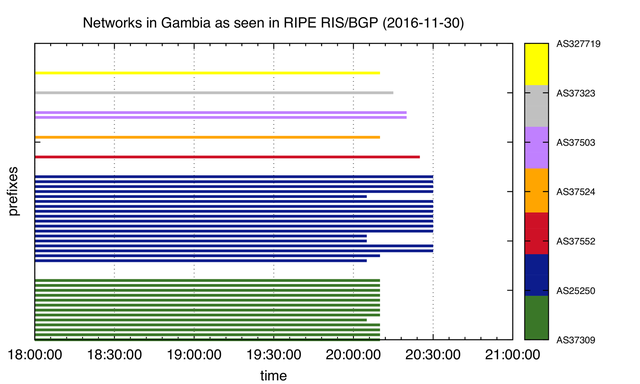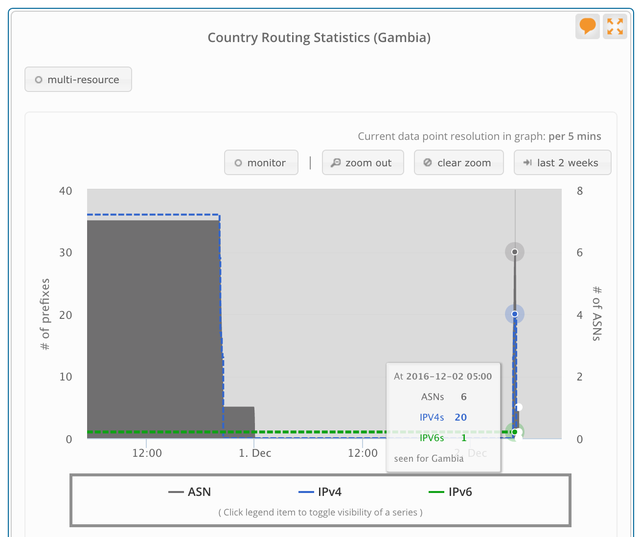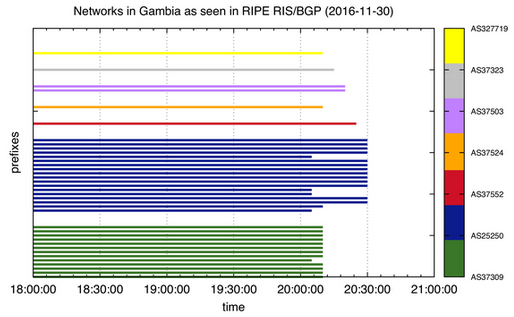We had a look at various RIPE NCC data sets to see what we can learn from yet another country-wide Internet outage in 2016.
Introduction
In the recent past we've seen an increase in partial or total Internet outages of countries, often at least correlated with political events.
On the evening of 30 November 2016, right before election day, The Gambia was added to this list. The Gambia is a country in West Africa of two million people. Its main connectivity to the rest of the Internet is through two subsea cables (ACE and GLO-1) (see Figure 1) and it has an Internet Exchange Point that was established in recent years: the Serrekunda Internet Exchange Point (SIXP).

Figure 1: The Gambia and submarine cables near it (image courtesy of Greg's Cable Map)
What we saw in BGP routing data, as collected by the RIPE Information Service (RIS), is that the six Autonomous Systems (ASes; typically 1 ISP uses 1 AS Number) withdrew all their networks from the global BGP routing system. We aggregate this data and provide a public near-realtime view of this per country in RIPEstat. Figure 2 shows a screenshot of the RIPEstat country-routing-stats widget for The Gambia right after we saw the Gambian networks disappear from the global Internet on 30 November.

Figure 2: Screenshot from the RIPEstat country-routing-stats widget for The Gambia, right after networks were withdrawn
If we look into our data on a per-ASN basis for this withdrawal (Figure 3) we see something interesting: While all networks withdrew between 20:00 and 20:30 UTC, there are per network differences as to when the networks were actually withdrawn. There are only two main cables and at least five different times when the last prefix for an ASN was withdrawn. So it is quite likely that the blockade was implemented on a per-ASN basis. We can speculate that this could be done by a series of phone calls from a government agency to the operators of the networks in question (like in Egypt in 2011) or that a decree was sent out to all operators which was then implemented at slightly different times.

Figure 3: BGP prefixes visible in RIPE RIS for Gambian ISPs over time. Horizontal lines are prefixes, coloured differently for different ISPs
On 2 December at around 5:00 UTC we saw a brief and partial restoration of the connectivity of The Gambia to the Internet as can be seen in Figure 4. It is unclear what caused this.

Figure 4: Short and partial restoration of the connectivity of The Gambia to the Internet
Conclusion
Earlier this year the United Nations Human Rights Council's published a resolution on the promotion, protection and enjoyment of human rights on the Internet, which condemns countries that intentionally disrupt their citizens' Internet access.
Despite this, it looks like The Gambia became yet another country whose government joined the ranks of those willing to block access to the wider Internet. For those concerned about a free and open Internet (I think that's a large part of the RIPE community), that should be a worrying trend. It would be interesting to calculate the economic cost of shutdowns like this.
For those who want to monitor the situation, the RIPEstat country-routing-statistic widget provides a near-realtime view of the Gambian networks at https://stat.ripe.net/GM.
We've also embedded the widget in this article, so people can follow the situation in near-realtime:
If we find more interesting information we'll update this article. We also encourage others who find interesting information to add that to this article in the comments section.





Comments 2
The comments section is closed for articles published more than a year ago. If you'd like to inform us of any issues, please contact us.
Emile Aben •
While we were busy pushing this post out, it looks like the Gambian Internet was restored, roughly around 12h UTC on 2 December. RIPE Atlas probes came online again, and we see 6 out of 7 ASNs in RIS data again.
Moses •
According to The Gambian electoral commission head, the incumbent president will concede defeat. That must have shaped the decision to have the Internet up again as it had been announced that it would be off up to Saturday.